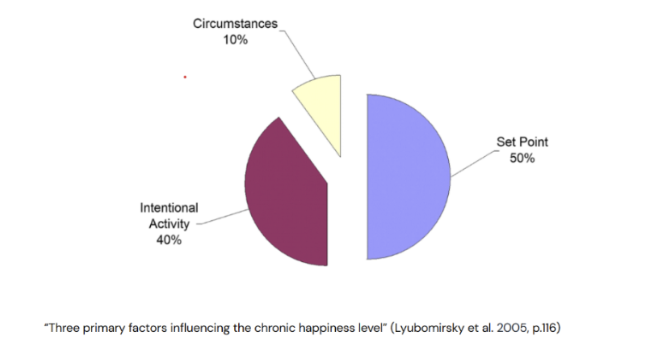What determines our happiness?Some might say more money, a flexible work schedule, a supportive spouse, a cure for your disability, but as it turns out, these factors will not make you considerably happier. According to research on happiness, around 50% of what determines our happiness is due to our genetic set point, i.e.,...

What determines our happiness?
Some might say more money, a flexible work schedule, a supportive spouse, a cure for your disability, but as it turns out, these factors will not make you considerably happier. According to research on happiness, around 50% of what determines our happiness is due to our genetic set point, i.e., genes/biology, 10% is due to life circumstances, such as income, social status, living conditions, etc., and 40% is due to our intentional behaviors, what we do and think on a daily basis (Lyubomirsky, 2008). Knowing that around 40% of our happiness is left up to what we do intentionally can provide you with a feeling of control over your ability to achieve greater and lasting happiness.

Is it worth it? Being happy?
Research on happiness has shown many reasons why one should strive for happiness and fulfillment. Other than feeling good, psychological literature concluded that compared to less happy peers, happier people are more sociable, energetic, charitable, cooperative, and more liked by others (Lyubomirsky, 2008). Happier individuals also demonstrate more flexibility with their thinking, are more productive, and tend to be better leaders and negotiators (Lyubomirsky, 2008). Those who report higher happiness are also more resilient to hardship, have stronger immune systems, and live longer, which in turn has benefits for their families and partners. (Lyubomirsky, 2008).
Why do life circumstances account for about 10% of our happiness?
Let’s talk about hedonic adaptation. “Hedonic adaptation refers to the notion that after positive or negative events (i.e., something good or bad happening to someone), and a subsequent increase in positive or negative feelings, people return to a relatively stable, baseline level of affect” (Diener, Lucas, & Scollon, 2006). For example, you might gain a boost in happiness for buying a new truck, or large screen TV, but perhaps you notice that in about a couple of weeks you have become used to that new truck and TV, to where it no longer provides that boost in happiness you initially had. Other examples include getting a makeover, moving into a bigger house, or obtaining that pay raise (Lyubomirsky, 2008).
So, what are some intentional activities I can do?
In The How of Happiness (2008), Dr. Sonja Lyubomirsky discusses in depth 12 activities to help foster lasting happiness. I will briefly cover three activities that you can begin today.
1) Expressing Gratitude
Expressing gratitude allows you to savor and take with you the maximum satisfaction from the circumstance that you are grateful for (Lyubomirsky, 2008). It also has been shown to improve your self-esteem, self-worth, as well as help you cope with stress and trauma (Lyubomirsky, 2008). Expressing gratitude can help you strengthen your relationships and inhibit your comparisons to others. That is, if you are truly grateful for what you have, then you may be less likely to focus and become envious of what others have (Lyubomirsky, 2008). Expressing gratitude can also combat negative emotions that may arise as well as hedonic adaptation that we discussed above. Simply put, expressing gratitude for what you have negates taking the good in your life for granted.
There are many ways to express gratitude. The one we will discuss is gratitude journaling. Get a journal, notepad, whatever you like, and take time to write down three to five things you are grateful for once a week. This can range from thanking your spouse for going grocery shopping, to being grateful for the birth of your child. Keep it current, true, and specific. To help remind yourself to write in your gratitude journal, mark a consistent time and day on your calendar, or set a recurring alarm on your phone.
2) Using Strategies for Coping
There are numerous coping strategies that can help you manage stressful and painful circumstances. One strategy involves thought disputation. Stemming from cognitive therapy, thought disputation is challenging your own pessimistic thoughts. The next time you become aware of an unhelpful thought, ask yourself:
“What specific evidence do I have for this belief or thought?”
“Are there any alternative explanations for this belief or thought?”
After questioning your unhelpful thoughts, you may conclude that some are simply not true.
3) Taking Care of Your Body
Many know the benefits of movement, quality sleep, and a nutrient-dense/whole-foods diet on one’s mental health. One practice that is often undervalued is meditation. There are many ways to meditate. However you choose to meditate, keep in mind these key elements:
-Be nonjudgmental and observe the present moment without evaluation.
-Be patient with yourself and trust yourself.
-Let go and set yourself free of ruminating thoughts.
(Lyubomirsky, 2008).
Meditation studies have revealed reduced symptoms of anxiety and depression, less reactivity to stress, and greater happiness (Lyubomirsky, 2008). To start, try meditating at least 20 minutes each day to begin noticing positive boosts in mood.
Final Thoughts
I often hear in my role as a counselor, “I just want to be happy.” And although the activities mentioned above have shown helpful for fostering happiness, it is not meant to replace evidenced-based treatments such as Cognitive Behavioral Therapy, EMDR, and medications for those experiencing symptoms of clinical depression and other mental disorders. It is, however, a complement to existing treatments that can only help you reach your therapeutic goals.
Diener, E., Lucas, R. E., & Scollon, C. N. (2009). Beyond the hedonic treadmill: Revising the adaptation theory of well-being. The science of well-being: The collected works of Ed Diener, 103-118.
Lyubomirsky, S. (2008). The how of happiness: A scientific approach to getting the life you want. penguin.












